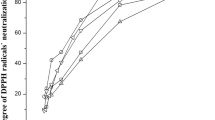Abstract
The deodoriser distillate (DOD) of Indian soybean oil obtained from two industries processing soybean oil was investigated for its physicochemical characteristics, its composition of tocopherols, phytosterols, fatty acids and recovery of phytosterols for use in nutraceutical products. It was found that the two DOD samples studied were dark in color and had higher amounts of free fatty acids (22.7 and 49.9%), unsaponifiable matter (11.8 and 21.9%) (5–10 times found in soybean oil), total tocopherols (1957–2256 mg/100 g) (20 times the amount in soybean oil), and 6–10% of phytosterols (12–20 times the soybean oil). The fatty acids found were palmitic (23.2–25.5%), stearic (1.4–2.4%), oleic (23.8–26.1%), linoleic (40.4–41.1%) and linolenic (2.7–3.2%) acids. The unsaponifiable matter (21.9%) and phytosterols (8.7%) content of DOD-2 were higher than in DOD-1 and hence was more suited for isolation of phytosterols. Using hexane and water for crystallisation, the DOD-2 yielded a phytosterol fraction with lower recovery of 13.2–17.8% while treatment with alkali to remove FFA and the glycerides followed by organic solvent extraction yielded unsaponifiable matter containing phytosterols with a recovery of 74.6%. Later the unsaponifiable matter was purified by double crystallisation into a mixture of phytosterols of 87% purity containing β-sitosterol (34.3%), stigmasterol (3.1%) and campesterol (50.1%). The product may find use in foods, pharmaceuticals, cosmetics and allied industries probably as a nutraceutical.


Similar content being viewed by others
References
Hovenkamp E, Demonty I, Plat J, Lutjohann D, Mensink RP, Trautwein EA (2008) Biological effects of oxidize phytosterols: a review of the current knowledge. Prog Lipid Res 47:37–49
Meijer GW (1999) Blood cholesterol-lowering plant sterols, types, doses and forms. Lipid Technol 11:129–132
Daguat D (2000) Phytosterols: highly promising compounds. Lipid Technol 12:77–84
Moreau RA, Nortan RA, Hicks KB (1999) Phytosterol and phytostanol lower cholesterol. Inform 10:572–577
Ling WH, Jones PJH (1995) Dietary phytosterols: a review of metabolism, benefits and side effects. Life Sci 57:195–206
Wang T, Hicks BK, Moreau R (2002) Antioxidant activity of phytosterols, oryzanol, and other phytosterol conjugates. J Am Oil Chem Soc 79:1201–1206
Ramamurthi S, Mccurdy AR (1993) Enzymatic pretreatment of deodorizer distillate for concentration of sterols and tocopherols. J Am Oil Chem Soc 70:287–295
Brown W (1964) Process for separating tocopherols and sterols from deodorizer sludge and the like. US Patent 3,153,054
Smith FE (1967) Separation of tocopherols and sterols from deodorizer sludge and the like. US patent 3,335,154
Hirota Y, Nagao T, Watanabe Y, Suenaga M, Nakai S, Kitano M, Sungihara A, Shimada Y (2003) Purification of steryl esters from soybean oil deodorizer distillate. J Am Oil Chem Soc 80:341–346
Lin KM (2003) Separation of sterols from deodorizer distillate by crystallization. J Food Lipids 10:107–127
Official methods and recommended practice of the American Oil Chemists’ Society (1997) 5th edn. Firestone D (ed) AOCS Press, Champaign. Method no: Ca 5a-40, Cd 8-53, Ca 6a-40, Ce 2-66, Ce 8-89, Ce 1-63
Van Wijngaarden D (1967) Modified rapid preparation of fatty acid esters from lipids for gas chromatographic analysis. Anal Chem 39:848–849
Holen B (1985) Rapid separation of free sterols by reverse phase high performance liquid chromatography. J Am Oil Chem Soc 62:1344–1346
Jiang Y, Wang T (2005) Phytosterols in cereal by-products. J Am Oil Chem Soc 82:439–444
Thanh TT, Vergnes MF, Kaloustian J, El-Moselhy TF, Amiot-Carlin M-J, Portugal H (2006) Effect of storage and heating on phytosterols concentrations in vegetable oils determined by GC/MS. J Sci Food Agric 86:220–225
Kochhar SP (1983) Influence of processing on sterols of edible vegetable oils. Prog Lipid Res 22:161–188
Verleyen T, Forcades M, Verhe R, Dewettinck K, Huyghebaert A, De Greyt W (2002) Analysis of free and esterified sterols in vegetable oils. J Am Oil Chem Soc 79:117–122
Moreau RA (2006) Plant sterols in functional foods. In: Dutta PC (ed) Phytosterols as functional food components and nutraceuticals. Marcel Dekker, New York, p 326
Nagesha GK, Manohar B, Udaya Sankar K (2003) Enrichment of tocopherols in modified soy deodorizer distillate using supercritical carbon dioxide extraction. Eur Food Res Technol 217:427–433
Watkins C (2005) The spread of phytosterols. Inform 16:344–345
Kochhar SP (2000) Stable and healthful frying oil for the 21st century. Inform 11:642–647
Makhal S, Mandal S, Kanawjia SK (2006) Phytosterols and stanols: the new age in designing novel functional dairy foods. Indian Food Ind 25:44–53
Acknowledgments
The authors are thankful to Dr. V. Prakash, Director of the Central Food Technological Research Institute, Mysore, for his keen interest and for providing infrastructural facilities and to Dr. B.R. Lokesh, Head, Lipid Science and Traditional Foods Department, for helpful discussions during the course of this work.
Author information
Authors and Affiliations
Corresponding author
About this article
Cite this article
Khatoon, S., Raja Rajan, R.G. & Gopala Krishna, A.G. Physicochemical Characteristics and Composition of Indian Soybean Oil Deodorizer Distillate and the Recovery of Phytosterols. J Am Oil Chem Soc 87, 321–326 (2010). https://doi.org/10.1007/s11746-009-1499-8
Received:
Revised:
Accepted:
Published:
Issue Date:
DOI: https://doi.org/10.1007/s11746-009-1499-8




